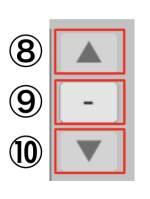Logic
It is an operation that has a function to read a message and notify the result of various calculations as a message.
What is logic
Logic is an operation that has the function of reading a message and notifying the result of various calculations as a message.
Setting items common to logic
The setting items of each logic component are as follows.

- Target and identifier of the signal that is the starting point for starting the calculation
- One step of calculation (executed in order from the top)
- Add step

- Target, identifier, and type to notify the calculated result as a message (If Signal is selected as the message type, the message will be notified when the calculation result is true).
- Applicable operators and functions
- Argument 1
- Argument 2 (The number of arguments depends on the function applied)
List of operators and functions that can be set in logic
| Operator / function | function |
|---|---|
| = | Returns the value of the argument as is. |
| Not | Returns false if the value is true. Otherwise, it returns true. |
| Minus | Returns the value with the positive and negative values reversed. |
| Add | Returns the sum of two values. |
| Multiply | Returns the product of two values. |
| Subtract | Returns the result of subtracting the value of argument 2 from the value of argument 1. |
| Divide | Returns the result of dividing the value of argument 1 from the value of argument 2. |
| Modulo | Returns the remainder after dividing the value of argument 1 from the value of argument 2. |
| Equals | Returns true if the two values are equal. Otherwise, it returns false. The Float type returns true if the two values are in the small range of each other. |
| NotEquals | Returns false if the two values are equal. Otherwise, it returns true. The Float type returns false if the two values are in the small range of each other. |
| GreaterThan | Returns true if the value of argument 1 is greater than the value of argument 2. Otherwise, it returns false. |
| GreaterThanOrEqual | Returns true if the value of argument 1 is greater than or equal to the value of argument 2. Otherwise, it returns false. |
| LessThan | Returns true if the value of argument 1 is less than the value of argument 2. Otherwise, it returns false. |
| LessThanOrEqual | Returns true if the value of argument 1 is less than or equal to the value of argument 2. Otherwise, it returns false. |
| And | Returns true if both of the two values are true. Otherwise, it returns false. |
| Or | Returns true if either of the two values is true. Otherwise, it returns false. |
| Condition | If the value of argument 1 is true, the value of argument 2 is returned. Otherwise, it returns the value of argument 3. |
| Min | Returns the smaller of the two values. |
| Max | Returns the larger of the two values. |
| Clamp | Returns argument 1 in the range of argument 2 or more and argument 3 or less. |
| Length | Returns the length of the argument vector. |
| Sqrt | Returns the square root of the argument. |
| Dot | Returns the dot product of two vectors. |
| Cross | Returns the cross product of two 3D vectors. |
| Rotate | If argument 1 is a number, it returns the value of the 2D vector of argument 2 rotated counterclockwise at the angle (degrees) of argument 1. If argument 1 is Vector3, then argument 1 returns the value obtained by applying the rotation shown as Euler angles (degrees) to the 3D vector of argument 2. |
Types of arguments that can be set in logic
| Argument type | function |
|---|---|
| Constant | Set when using a constant and specify the type and value. |
| RoomState | Set when reading and using the message, and specify the type, target, and identifier. If you use the Double type, you can read all the value types in common. |
For details on message types and values, see Trigger common settings.

- Replace with the steps above
- Delete step
- Replace with the steps below